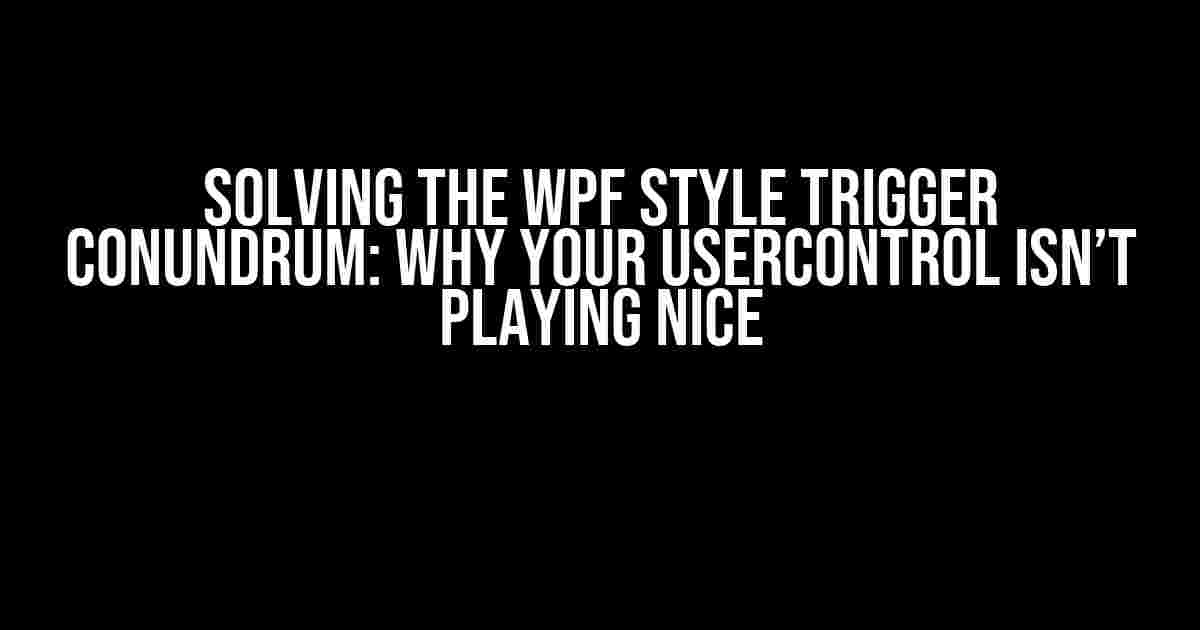Ah, WPF, the wonderland of rich UI experiences and… occasionally, hair-pulling frustration. One such frustration is when your WPF style trigger, carefully crafted to bring harmony to your UserControl, simply refuses to propagate. In this article, we’ll dive into the mysterious realm of WPF styling, explore the common pitfalls, and provide a step-by-step guide to resolving this particular issue.
The Problem: WPF Style Trigger of UserControl Not Propagated
Imagine you’ve created a beautiful, reusable UserControl, complete with its own set of styles and triggers. You’ve applied a style to the UserControl, which includes a trigger that changes the UserControl’s appearance when a certain condition is met (e.g., when the UserControl is hovered). However, when you use this UserControl within another control or window, the style trigger seems to vanish into thin air. The UserControl looks great on its own, but the style trigger remains stubbornly inactive.
Why Does This Happen?
There are a few reasons why your WPF style trigger might not be propagating to your UserControl:
- Inheritance: WPF’s styling mechanism relies heavily on inheritance. If your UserControl isn’t correctly inheriting the style from its parent, the trigger won’t work.
- Resource Dictionary Merges: When you define your UserControl’s styles in a separate resource dictionary, WPF might not merge them correctly with the parent control’s resources.
- Overrides: Unintentional overrides in your UserControl’s style or templates can negate the trigger’s effect.
- DataContext Issues: If the DataContext of your UserControl is not properly set or is conflicting with the parent control’s DataContext, the trigger might not function as expected.
Solution 1: Verify Inheritance and Resource Dictionary Merges
To ensure proper inheritance and resource dictionary merges:
Define your UserControl's styles in the same resource dictionaryas the parent control, or import the UserControl’s resource dictionary into the parent control’s resources.- Make sure the
x:Keyattribute is set for your style, and that you’re referencing the correct key in your UserControl’sStyleattribute. - In your UserControl’s XAML, explicitly set the
DataContextto the correct instance, using theDataContext="{Binding RelativeSource={RelativeSource Self}}"syntax.
<ResourceDictionary>
<!-- Define your UserControl's styles here -->
<Style x:Key="MyUserControlStyle" TargetType="{x:Type UserControl}">
<!-- Your style triggers and setters go here -->
</Style>
</ResourceDictionary>
Solution 2: Check for Overrides and Conflicts
To identify and resolve overrides and conflicts:
Review your UserControl's XAMLfor any explicitly set properties that might be overriding the style trigger.Use the WPF Debuggerto inspect the visual tree and identify any unexpected style or template overrides.- If you’re using a custom control template, ensure that it doesn’t contain any
TemplateBindingsthat might be overriding the style trigger.
<ControlTemplate x:Key="MyUserControlTemplate">
<!-- Avoid using TemplateBindings that might override your style trigger -->
<Border Background="{TemplateBinding Background}" />
</ControlTemplate>
Solution 3: DataContext and Binding Issues
To resolve DataContext and binding issues:
Verify that your UserControl's DataContextis correctly set to an instance that contains the necessary data for the style trigger.Use a debugger or visualization toolto inspect the binding and DataContext at runtime.- If you’re using a
DataTemplate, ensure that it’s correctly bound to the DataContext and that the style trigger is referencing the correct property.
<DataTemplate x:Key="MyDataTemplate"> <!-- Verify that the DataContext is correctly set and referenced --> < BINDINGS AND STYLE TRIGGERS GO HERE > </DataTemplate>
Conclusion: WPF Style Trigger of UserControl Now Propagated!
By following these steps and verifying the common pitfalls, you should now have a WPF style trigger that propagates correctly to your UserControl. Remember to:
- Ensure proper inheritance and resource dictionary merges.
- Check for overrides and conflicts in your UserControl’s XAML and control templates.
- Verify the DataContext and binding issues that might affect the style trigger.
With these solutions, you’ll be well on your way to creating reusable, stylish UserControls that play nicely with WPF’s styling mechanism. Happy coding!
| Common Issues | Solutions |
|---|---|
| Inheritance | Verify resource dictionary merges and inheritance |
| Overrides | Check for explicit property setters and TemplateBindings |
| DataContext Issues | Verify DataContext and binding issues at runtime |
Frequently Asked Question
Get the answers to your burning questions about WPF style triggers of usercontrols not being propagated!
Why isn’t my WPF style trigger working when I apply it to a UserControl?
This is a common gotcha! When you apply a style trigger to a UserControl, it only affects the UserControl itself, not its child elements. To fix this, you need to set the Style property on the child elements explicitly, or use a implicit style that targets the child elements’ types.
I’ve set the Style property on the child elements, but the trigger still isn’t working. What am I doing wrong?
Double-check that you’re not using a based-on style that’s overriding the trigger. Also, make sure the trigger is defined in the correct scope – if it’s defined in a resource dictionary, ensure that the dictionary is merged correctly.
How do I debug a WPF style trigger that’s not working as expected?
Use the WPF Tree Visualizer or Snoop to inspect the visual tree and check that the style is being applied correctly. You can also use the Output window in Visual Studio to debug binding issues. And don’t forget to check the WPF error messages – they can give you valuable clues about what’s going wrong!
Can I use a DataTrigger to trigger a style change in a UserControl?
Yes, you can! A DataTrigger is perfect for triggering a style change based on a data condition. Just set the DataContext of the UserControl to the data object, and define the DataTrigger in the UserControl’s style. Easy peasy!
Why do I need to set the OverridesDefaultStyle property to true in my UserControl?
This property tells WPF to use the style defined in the UserControl’s XAML instead of the default style. Without it, your UserControl might not pick up the style changes triggered by the style trigger. So, don’t forget to set it to true to avoid headaches!
